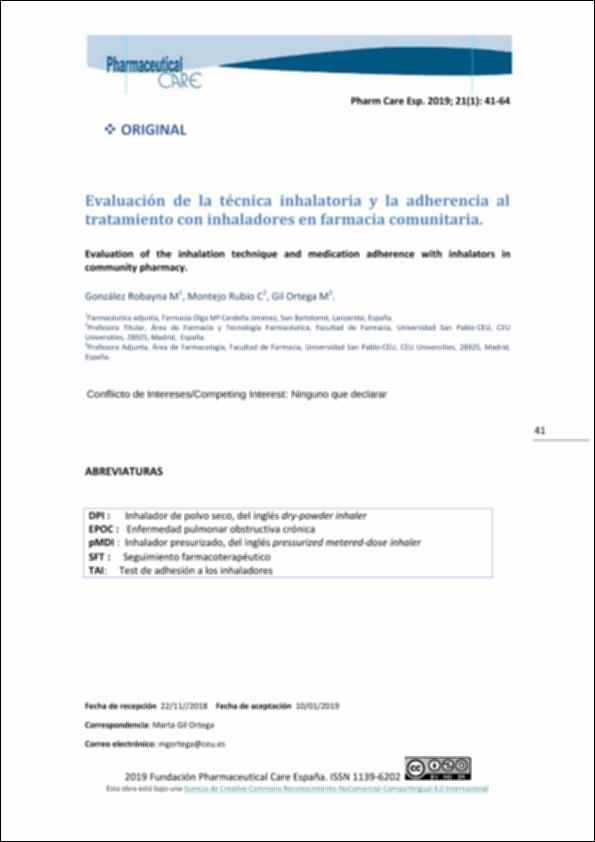Por favor, use este identificador para citar o enlazar este ítem:
http://hdl.handle.net/10637/14755Evaluación de la técnica inhalatoria y la adherencia al tratamiento con inhaladores en farmacia comunitaria
| Título : | Evaluación de la técnica inhalatoria y la adherencia al tratamiento con inhaladores en farmacia comunitaria |
| Autor : | González Robayna, M. Montejo Rubio, María Consuelo Gil Ortega, Marta |
| Materias: | Técnica inhalatoria; Adherencia al tratamiento; Inhaladores; Inhalation technique; Inhalators |
| Editorial : | Fundación Pharmaceutical Care España |
| Citación : | González Robayna, M. M., Montejo Rubio, C., & Gil Ortega, M. (2019). EVALUACIÓN DE LA TÉCNICA INHALATORIA Y LA ADHERENCIA AL TRATAMIENTO CON INHALADORES EN FARMACIA COMUNITARIA. Pharmaceutical Care España, 21(1), 41–64. Recuperado a partir de https://www.pharmcareesp.com/index.php/PharmaCARE/article/view/490 |
| Resumen : | Most of the drugs used to treat obstructive pulmonary diseases are administered by the inhalation route. However, an incorrect inhalation technique may compromise the control of these pathologies. Objectives: The aim of this study was to evaluate the inhalation technique on patients of a community pharmacy and their medication adherence. Methods: A descriptive, cross-sectional observational study was carried out with 59 patients treated with inhalers who were surveyed on their inhalation technique and adherence to treatment. In addition, they were asked for a practical demonstration of their inhalation technique. Results: 47% of the surveyed patients committed critical inhaler use errors despite the fact that 97.3% of them considered they knew how to use properly their devices. The most frequent error was not to wait at least one minute between inhalations when it was necessary to repeat doses. Although 96% of the surveyed patients assured to have received information about how to use the inhaler, only 1% was provided by pharmacists. 47% of the patients showed a good adherence to the treatment. Nevertheless, 60% showed some type of non-compliance, being the erratic non-compliance the most frequent one. Conclusion: This study shows that a high percentage of patients present an incorrect inhalation technique and have a poor therapeutic adherence, which can contribute to a lower effectiveness of the treatment and a worse control of their health problems. A more active role of community pharmacists is needed to prevent this situation. |
| Descripción : | Este artículo se encuentra dispponible en la siguiente url: https://www.pharmcareesp.com/index.php/PharmaCARE/article/view/490 |
| URI : | http://hdl.handle.net/10637/14755 |
| Derechos: | OpenAccess http://creativecommons.org/licenses/by/4.0/deed.es |
| ISSN : | 2794-1140 |
| Fecha de publicación : | 14-feb-2019 |
| Centro : | Universidad San Pablo-CEU |
| Aparece en las colecciones: | Facultad de Farmacia |
Los ítems de DSpace están protegidos por copyright, con todos los derechos reservados, a menos que se indique lo contrario.


